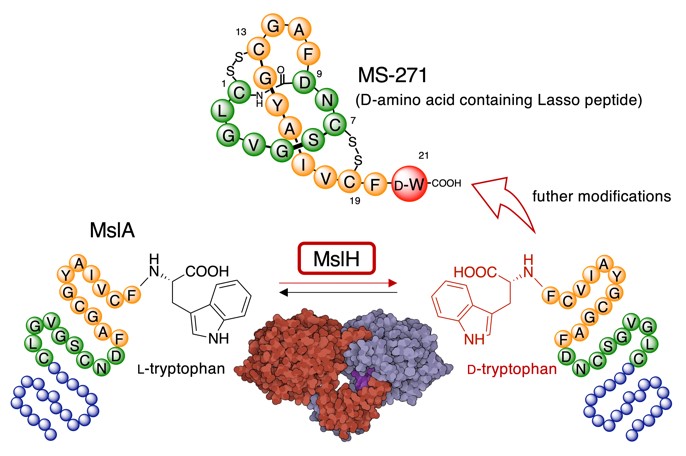The elucidation of the mechanism underlying the incorporation of D-amino acids into the Lasso peptide
Summary
The D-amino acid introduction mechanism into a unique Lasso peptide has been elucidated for the first time by a research team headed by Prof. Hiroyuki Morita (Institute of Natural Medicine, University of Toyama) in conjunction with a research team led by Prof. Tohru Dairi (Graduate School of Engineering at Hokkaido University). This study aimed to investigate how D-amino acids are incorporated into the Lasso peptide MS-271, derived from microbes, and to explore the potential for generating novel functional peptides. While L-amino acids typically constitute lasso peptides, MS-271 is the sole identified Lasso peptide incorporating D-amino acids in its body. It is worth noting that peptides containing D-amino acids have been documented to exhibit physiological activities, including antibacterial properties. The D-amino acid containing Lasso peptide MS-271 is a promising platform for developing new functional peptides. In this work, the research team analyzed the three-dimensional configuration of the MslH enzyme, which is responsible for incorporating D-amino acids in MS-271. The study aimed to elucidate the mechanism by which MslH introduces D-amino acids, marking a significant advancement in our understanding of this process. Furthermore, it has been demonstrated that this enzyme possesses distinct characteristics that a singular evolutionary mechanism has gained. The obtained results support the manipulation of MslH functions with the potential to generate novel functional peptides. The study findings have been published in Nature Communications, based in the United Kingdom.

Background
Peptides comprise an interconnected chain of 2-50 amino acids and typically lack inherent physiological functionality. During ingestion, the human body utilizes digestive enzymes to break down proteins present in food into peptides. Subsequently, these peptides undergo further degradation, resulting in the formation of amino acids. Our human then absorbs these amino acids, utilizing them as a valuable source of nutrition. Interestingly, several peptides exhibit physiological properties, including lowering blood pressure, exerting antibacterial effects, and inhibiting memory formation. The peptides are called “functional peptides,” produced by the human body’s enzymatic breakdown of dietary proteins. However, it is important to note that the variety of these peptides is somewhat restricted. In contrast, numerous organisms, including microorganisms and plants, can generate diverse functional peptides by implementing various structural modifications to some kinds of peptides. These peptides with steric functional properties differ from typical peptides, making them potential candidates for developing novel functional peptides. Specifically, there is growing interest in the peptides generated by certain microorganisms, referred to as “Lasso peptides,” due to their distinctive “lasso” structure and exceptional thermal stability. Lasso peptides exhibit distinct characteristics compared to other peptides and have been found to possess diverse physiological actions, including antibacterial capabilities. This work primarily examined Lasso peptide MS-271, obtained from various actinomycetes, including Streptomyces sp. M-271.
It is widely recognized that Lasso peptides are constructed from L-amino acids, the same as the typical peptide. Nevertheless, the structure of the Lasso peptide MS-271 incorporates a D-tryptophan, a D-amino acid at the C-terminus. There are no other reported Lasso peptides containing such D-amino acids. It is essential to highlight that functional peptides containing D-amino acids have been extensively reported to exhibit diverse physiological activities, including antibacterial properties. The presence of D-amino acids in Lasso peptides is anticipated to provide valuable insights into the discovery and design of novel functional peptides.
Significance of the research and prospects
The enzyme MslH has been identified as the catalyst for incorporating the D-amino acid in the Lasso peptide MS-271. The conversion of L-tryptophan, an L-amino acid located at the C-terminus of MslA, the precursor peptide of MS-271, is catalyzed by MslH, resulting in the formation of D-tryptophan, a D-amino acid. This study employed X-ray crystallography to understand the three-dimensional mechanism by which MslH binds to the precursor peptide MslA and facilitates its conversion into D-amino acids. This finding demonstrates that whereas MslH is the sole enzyme responsible for producing D-amino acid-containing Lasso peptides, its three-dimensional structure is remarkably similar to calcineurin utilized across various taxa, from our human to yeast. Note that calcineurin, a protein phosphatase, plays a significant part in intracellular signal transduction, and the functions are distinct from those of MslH. In other words, Streptomyces sp. M-271 and related species could have made it possible to produce D-amino acid-containing Lasso peptides by a unique evolution of MslH from the typical calcineurin.
The researchers anticipated that by the artificial alteration of MslH, a diverse range of D-amino acid-containing Lasso peptides could be synthesized, expanding the repertoire beyond what is seen in nature and resulting in the emergence of novel functional peptides. The discovery that the unique development of MslH has facilitated the synthesis of Lasso peptides containing D-amino acids is a significant advancement in biology and biotechnology. This study significantly contributed to pharmaceuticals and biotechnology by enhancing our comprehension of the enzymatic processes via which microorganisms synthesize functional peptides.
Publication information
Journal
Nature Communications
Publication Date
Aug. 8, 2023
Title
Structure of lasso peptide epimerase MslH reveals metal-dependent acid/base catalytic mechanism.
Authors
Nakashima, Y., Kawakami, A., Ogasawara, Y., Maeki, M., Tokeshi, M., Dairi, T., Morita, H.

